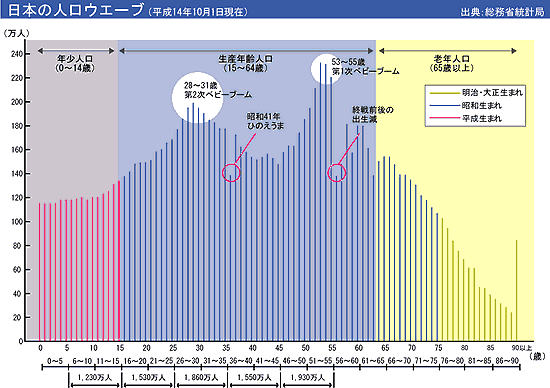Population Wave
I thought of the gpopulation waveh diagram shown below about 25 years ago. My reason for doing so was that, looking at the population pyramid issued by the Ministry of Health and Welfare based on the national census, I thought it would be better to make a graph that was easier to read, like the one below.
That time was the golden age of analog audio, and the market was expanding and growing by leaps and bounds. However, the reality of the situation was that we did not understand specifically what the energy behind that growth was. It was then that I came across Taichi Sakaiyafs book Dankai no sedai (The Baby-Boom Generation). When I read that book, I remember, I fell into such a state of excitement that my heart raced furiously.
The industry as a whole understood from the population pyramid that, given the existence of the baby-boom generation, the audio boom was going to continue for a while. In particular, system proposals for the purchasing group aged 16 ? 26 years blossomed with the home stereo system genre, and individual components also continued to set new records.
Setting the 16 ? 26 age group as the purchasing zone and looking at this group as a kind of school, we could look ahead into the future of the industry by fixing this 16 ? 26 zone, with new students coming in to take the place of older students who graduated. I realized that, while keeping an eye on the population pyramid, the population wave at that time enabled us to have a more definite understanding of both future and present conditions. Indeed, it became a very useful weapon in marketing.
Around the time when the baby-boom generation began to move away from the purchasing zone, the audio business fell into a slump. Even though the purchasing zone population was shrinking, the businessfs production and sales setup assumed that it was plentiful. Accordingly, the industry was suddenly hit by inventory surplus and price confusion, and it tumbled into a recession.
The population wave is a graph. However, it is human beings that make up this graph. If we recognize the essential point that nothing would happen if human beings did not exist, then the population wave becomes a real living creature. The graph brims with the human mind. And technology, which is created by people, is the very essence of the human mind.
Masaru Ibuka, the cofounder of Sony, taught me that gtechnology is interface with the human mind.h As long as the human race continues to exist, then this human mind, its very essence, will continue to exist as well. Technology, which is created therein, will have no value unless it is firmly linked to the mind.
Keeping an eye on the future through the fusion of these minds behind the population wave and technology gives me a certain kind of pleasure.
